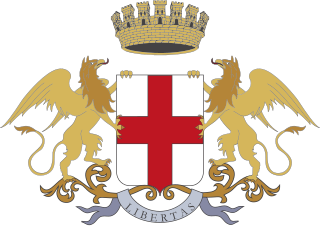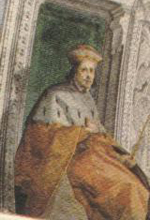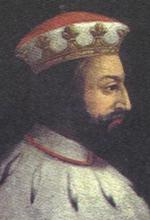
The Guelphs and Ghibellines were factions supporting respectively the Pope and the Holy Roman Emperor in the Italian city-states of Central Italy and Northern Italy during medieval time.

The Doge of Genoa was the head of state of the Republic of Genoa, a city-state and soon afterwards a maritime republic, from 1339 until the state's extinction in 1797. Originally elected for life, after 1528 the Doges were elected for terms of two years. The Republic was ruled by a small group of merchant families, from whom the doges were selected.

The Republic of Genoa was a medieval and early modern maritime republic from the 11th century to 1797 in Liguria on the northwestern Italian coast. During the Late Middle Ages, it was a major commercial power in both the Mediterranean Sea and the Black Sea. Between the 16th and 17th centuries, it was one of the major financial centers in Europe.

Simone Boccanegra was the first Doge of Genoa. He became doge in 1339, but was ousted from power six years later. He regained the position in 1356, retaining it until his death in 1363.

A doge was an elected lord and head of state in several Italian city-states, notably Venice and Genoa, during the medieval and Renaissance periods. Such states are referred to as "crowned republics".
An Albergo was a term used during the Renaissance to indicate an organizational structure in which several families linked by blood or a common interest banded together. The different families derived economic, political, or military support from each other. They usually lived near each other and attended the same churches.

Gabriele Adorno (1320–1383) was the fourth Doge of Genoa. A member of the Adorno family, he was elected on March 14, 1363 to succeed Simone Boccanegra, who had died in office. He remained in the position until August 13, 1370, when he was deposed by the people of Genoa. He was succeeded by Domenico di Campofregoso.

Giano I di Campofregoso was the 31st Doge of the Republic of Genoa.

Pietro Campofregoso was Doge of Genoa from 1450 to 1458.

Lodovico di Campofregoso (1415–1489) was an Italian nobleman who was three times doge of Genoa.

Domenico di Campofregoso (1325–1390) was the fifth doge of Genoa. He succeeded Gabriele Adorno upon the deposition of the latter on August 13, 1370 by the two vicars of the people. He held the longest consecutive term as Doge in the history of the Republic.

The Most Serene Prince Antoniotto Adorno was the 6th doge of the Republic of Genoa and rose four times to this supposedly lifelong position, making him the person most often elected to the Doge office in the history of the republic.

Nicolò Guarco was a Genoese statesman who became the 7th doge of the Republic of Genoa and led the Republic through the War of Chioggia against Venice.

Ottaviano Fregoso was the Doge of the Republic of Genoa.

Giacomo Fregoso or Campofregoso (1340–1420) was a statesman who became the 10th doge of Genoa.

Pietro Fregoso was a statesman who became the 13th Doge of Genoa.

Antonio Guarco was the 20º doge of the Republic of Genoa.

The House of Fregoso or di Campofregoso was a noble family of the Republic of Genoa and Liguria in general, divided into numerous branches, whose members distinguished themselves on numerous historical occasions; many of them held the position of Doge of Genoa, some were also lords of Sarzana; others finally held various fiefdoms, lands and titles along the arc of the Ligurian Apennines, such as the county of Sant'Agata Feltria which was owned by Agostino Fregoso. The Fregoso family monopolized the Dogate's lifetime office, becoming the dynasty who produced the highest number of doges in the history of the Republic.
Guglielmo Boccanegra was a Genoese statesman, the first capitano del popolo of the Republic of Genoa, from 1257 to 1262, exercising a real lordship, assisted in the government by a council of 32 elders.

Barnaba Guano was the 23rd Doge of the Republic of Genoa.












